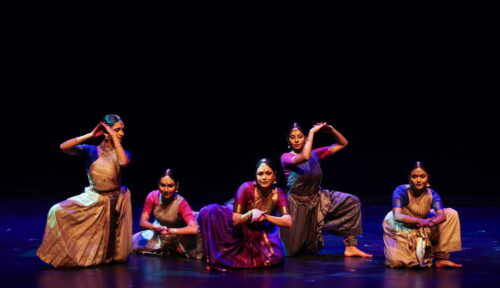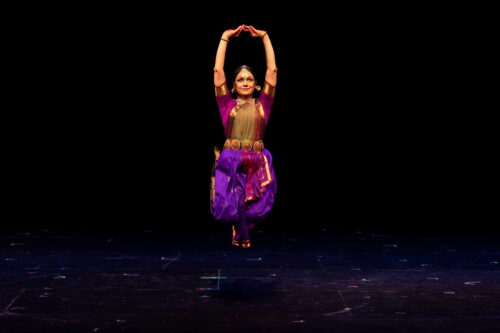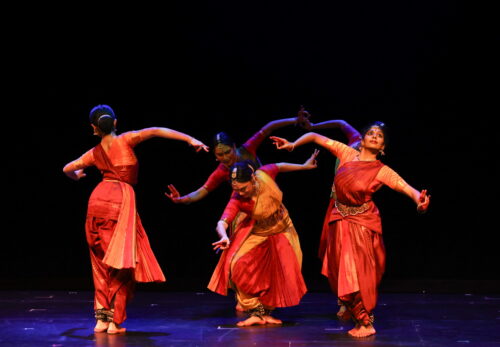Rama Vaidyanathan’s ‘New Dimensions to the Maargam’ presented by Samskriti

The Maargam in the south Indian classical dance form of Bharatanatyam has always held a fascination for me. Conceived as a format for the traditional solo recital, the Maargam represents the idea of an emotional, spiritual journey undertaken by a dancer through her repertoire, on which, if the performer is sufficiently skilled, the audience is brought along. The emotions of the dancer become those of the audience, and the line between the performing stage and the watching audience is blurred and disappears.
Indian Performing Arts Samskriti presented internationally acclaimed dancer/choreographer Rama Vaidyanathan’s ‘New Dimensions to the Maargam’ on Saturday, November 11 at Midtown Arts & Theater Center Houston. The title of the work does not exaggerate. From the addition of four brilliant young dancers who danced as one, to the carefully curated individual pieces, each a refreshing burst of unexpectedly charming ideas and emotions, to the signature uniqueness of Rama’s choreography that somehow challenges traditional vocabulary while staying firmly within it – New Dimensions was an hour and a half of brilliant artistry that kept the audience guessing, riveted, and at the end, wanting more.

The opening piece, a Mallari, woven in with Sanskrit verses describing Krishna as a lake in which the poet is immersed, set the tone for the choreographic lyricism of the evening. Rama’s choreography had the five-member ensemble moving as one entity with distinct identities, somehow perfectly in harmony while retaining individuality. Fish jumped out of the sea, lotuses bloomed and waved, ripples surfaced and smoothed, and one could almost see the play of sunlight shining beneath the waters. The final undulating tableau saw the devotee fully submerged beneath the surface.
From the visual feast of the Mallari, one might have expected the anchoring piece of the evening, Varnam, performed as a solo, to be somehow less satisfying. One would underestimate the prowess of Rama as a soloist. Commanding and covering the stage for an unbroken thirty-plus minutes, Rama drenched the audience in her exploration of the journey of a lovestruck Meera yearning for her Krishna, as mirrored in the advent of rains. One smelled the monsoon in the air, sensed the cool breeze heralding imminent showers, felt those first drops falling, and exulted in the downpour when it finally arrived.
The delightful Abhang, performed by the four dancers, was an irreverently reverent exploration of innocence in devotion. Portraying schoolchildren who goodnaturedly tease, lightly taunt, play with, and compete against each other in their expression of devotion to Lord Panduranga, the four young dancers – Kavya Ganesh, Reshika Sivakumar, Shubhamani Chandrashekar and Vaishnavi Dhore – shone bright in this piece. Perfect geometry competed with nuanced abhinaya (emotive expression) for the audience’s attention, and perhaps most refreshing, none of it was taken too seriously, with the pouting, dragging exit of the dancers providing a perfectly conceived lightness to offset the intensity of preceding pieces.

Rama returned solo to the stage in Prem Gatha, a lyrical Bengali song in which the heroine bids a firm and amused farewell to a lover unwilling to depart. Tailormade for Rama’s trademark style of abhinaya – poised, subtle, mature, and flawlessly timed – this piece was the perfect next step in the Maargam. retaining a lightness of mood balanced by a depth born of experience – both that of the clearly mature heroine of the piece, and that of the soloist as a performer. Both were quintessentially illustrated at the very end of the piece, with the heroine inviting her lover back in with a leisurely raised eyebrow and a slowly spreading smile.
Rama’s choice of concluding piece, Shwaasam, seamlessly encapsulated all of the new dimensions explored in her maargam. The undulating choreography from the first piece was mirrored here, as was the beautiful synchrony of movement. Power and beauty competed as the dancers portrayed elements of the universe melding into one harmonious whole, with the lights going down on the dancers moving with the rise and ebb of breath itself, and, I imagine, the audience breathing in accord.
Mention must be made of the brilliant young musicians – Ashwin Subramanian (nattuvangam), Anugrah Lakshmanan (vocal), Sannidhi Vaidyanathan (mridangam), and Vishwesh Swaminadhan (violin). In particular, Vishwesh gave the impression of being a one-person string ensemble, cajoling sounds and harmonies out of his violin that were reminiscent of at least a quartet playing together. The introductions of each piece by Rama and her students were thoughtfully constructed and beautifully delivered, adding to the coherence of the evening.
A wonderful finale indeed to this year’s season of shows presented by Rathna Kumar’s Samskriti Indian Performing Arts!
About the author: Dr. Lavanya Rajagopalan is a dancer/choreographer, educator, scientist, and writer who resides in Houston. She is the founder and Executive Artistic Director of Silambam Houston, an Indian classical arts nonprofit.



Thank you Lavanya, for such a wonderful and beautifully worded review. Samskriti is very grateful to DSH for making it possible for people to know, through Lavanya’s review, about the fantastic programs that Samskriti brings to Houston.
This is such a beautifully written review, detailed and informative. Thank you Lavanya for your sensitive portrayal of my work, it made me go through the whole performance through your inner eye. Thank you Samskriti and Rathna Kumar for believing in me and bringing this work to Houston.
Beautifully penned with insights into the audience experience, kudos to the writer Lavanya. Congratulations to Rama and her team. Congratulations to Rathna for presenting this work an inspiration to all who are invested in Bharatanatyam.